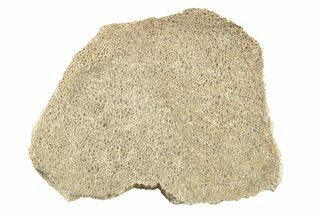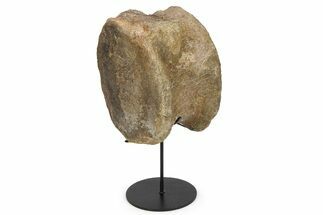This Specimen has been sold.
2.2" Dinosaur Bone (Gembone) Slice - Colorado
This is a slice of agatized, Late Jurassic-aged dinosaur bone from Colorado. It has been cut flat on both sides which allows for the beautiful internal cell structure to be easily seen. The small cells would be indicative of a non-theropod dinosaur, almost certainly one of the large sauropods like Diplodocus or Camarasaurus which are relatively common in the Morrison Formation.
The material is perfect for polishing!
The material is perfect for polishing!
Agatized or agate replaced dinosaur bone is a rare form of fossilized dinosaur bone where the original fossilized bone, typically permineralized with calcite, has been re-mineralized with silica-type compounds such as agate, jasper, chalcedony, or opal.
In a unique and isolated circumstance, the strata on the Colorado Plateau were uplifted during the tertiary intrusions about 35 million years ago when the San Rafael Swell and the La Sals, Henry, and Abajo Mountains were formed. As these ranges were forming, local strata layers were flooded with silica-rich, superheated groundwater. This provided the appropriate environment to start this calcite-silicate replacement in the original fossils. The most prolific layers of gem bone come from the Morrison Formation, which is late Jurassic in age.
In a unique and isolated circumstance, the strata on the Colorado Plateau were uplifted during the tertiary intrusions about 35 million years ago when the San Rafael Swell and the La Sals, Henry, and Abajo Mountains were formed. As these ranges were forming, local strata layers were flooded with silica-rich, superheated groundwater. This provided the appropriate environment to start this calcite-silicate replacement in the original fossils. The most prolific layers of gem bone come from the Morrison Formation, which is late Jurassic in age.
About The Morrison Formation
Located in the midwestern United States, the Late Jurassic-aged Morrison Formation is an incredibly large and fossiliferous formation that dates back to about 156 to 147 million years old. Named after the small town of Morrison, Colorado, the formation was discovered in 1877, and quickly became the center of one of the biggest rivalries in historical paleontology.
19th century paleontologists Othniel Charles Marsh and Edward Drinker Cope spent 15 years making outstanding strides in the discovery of fossils all throughout the American Midwest, but also resorted to unsavory methods in attempts to discredit or ruin the other's work and reputation, including destruction of specimens.
The total area of the formation is roughly 600,000 square miles, but much of that is inaccessible, deeply buried under prairie land and eroded during the formation of the Rocky Mountains. Even so, many outcroppings across the Front Range and upper Midwest allow paleontologists access to a wealth of information from Late Jurassic North America.
Dinosaurs from the region include large allosaurid dinosaurs, such as the eponymous Allosaurus and its larger relative Saurophaganax. Both exceeded 30 feet in length, making them some of the largest carnivores of their time. They competed with the similarly large megalosaurid Torvosaurus, and the somewhat smaller horned ceratosaurid, Ceratosaurus. On the smaller end of the theropod family tree was the raptor-like Ornitholestes.
For herbivores, Stegosaurus guarded their herds with huge, intimidating backplates and formidable tail spikes. Small, early ankylosaurs like Gargoyleosaurus would have fed on the forested understory, smaller in size than the 30+ foot giant Stegosaurids.
However, the Morrison Formation's main attraction were the giant sauropod dinosaurs, some of the most colossal of dinosaurs and largest land animals of all time. Diplodocus, Camarasaurus, Apatosaurus, Brontosaurus, Brachiosaurus, Barosaurus, and Supersaurus all count themselves among these long-necked titans. None of these herbivores would have been less than 50 feet in length at adult size: the largest of their number would have exceeded 100-115 feet in length, and over 40 tons. For so many sauropods to have lived in roughly the same place and time, they all likely developed different feeding and living strategies to minimize competition. Their massive sizes and herds would have defended them well from any of the numerous predators of the Morrison.
Located in the midwestern United States, the Late Jurassic-aged Morrison Formation is an incredibly large and fossiliferous formation that dates back to about 156 to 147 million years old. Named after the small town of Morrison, Colorado, the formation was discovered in 1877, and quickly became the center of one of the biggest rivalries in historical paleontology.
19th century paleontologists Othniel Charles Marsh and Edward Drinker Cope spent 15 years making outstanding strides in the discovery of fossils all throughout the American Midwest, but also resorted to unsavory methods in attempts to discredit or ruin the other's work and reputation, including destruction of specimens.
The total area of the formation is roughly 600,000 square miles, but much of that is inaccessible, deeply buried under prairie land and eroded during the formation of the Rocky Mountains. Even so, many outcroppings across the Front Range and upper Midwest allow paleontologists access to a wealth of information from Late Jurassic North America.
Dinosaurs from the region include large allosaurid dinosaurs, such as the eponymous Allosaurus and its larger relative Saurophaganax. Both exceeded 30 feet in length, making them some of the largest carnivores of their time. They competed with the similarly large megalosaurid Torvosaurus, and the somewhat smaller horned ceratosaurid, Ceratosaurus. On the smaller end of the theropod family tree was the raptor-like Ornitholestes.
For herbivores, Stegosaurus guarded their herds with huge, intimidating backplates and formidable tail spikes. Small, early ankylosaurs like Gargoyleosaurus would have fed on the forested understory, smaller in size than the 30+ foot giant Stegosaurids.
However, the Morrison Formation's main attraction were the giant sauropod dinosaurs, some of the most colossal of dinosaurs and largest land animals of all time. Diplodocus, Camarasaurus, Apatosaurus, Brontosaurus, Brachiosaurus, Barosaurus, and Supersaurus all count themselves among these long-necked titans. None of these herbivores would have been less than 50 feet in length at adult size: the largest of their number would have exceeded 100-115 feet in length, and over 40 tons. For so many sauropods to have lived in roughly the same place and time, they all likely developed different feeding and living strategies to minimize competition. Their massive sizes and herds would have defended them well from any of the numerous predators of the Morrison.
SPECIES
Unidentified Sauropod
LOCATION
Colorado
FORMATION
Morrison Formation
SIZE
2.2 x 1.2", .15" thick
CATEGORY
SUB CATEGORY
ITEM
#286440
We guarantee the authenticity of all of our specimens.
 Reviews
Reviews











